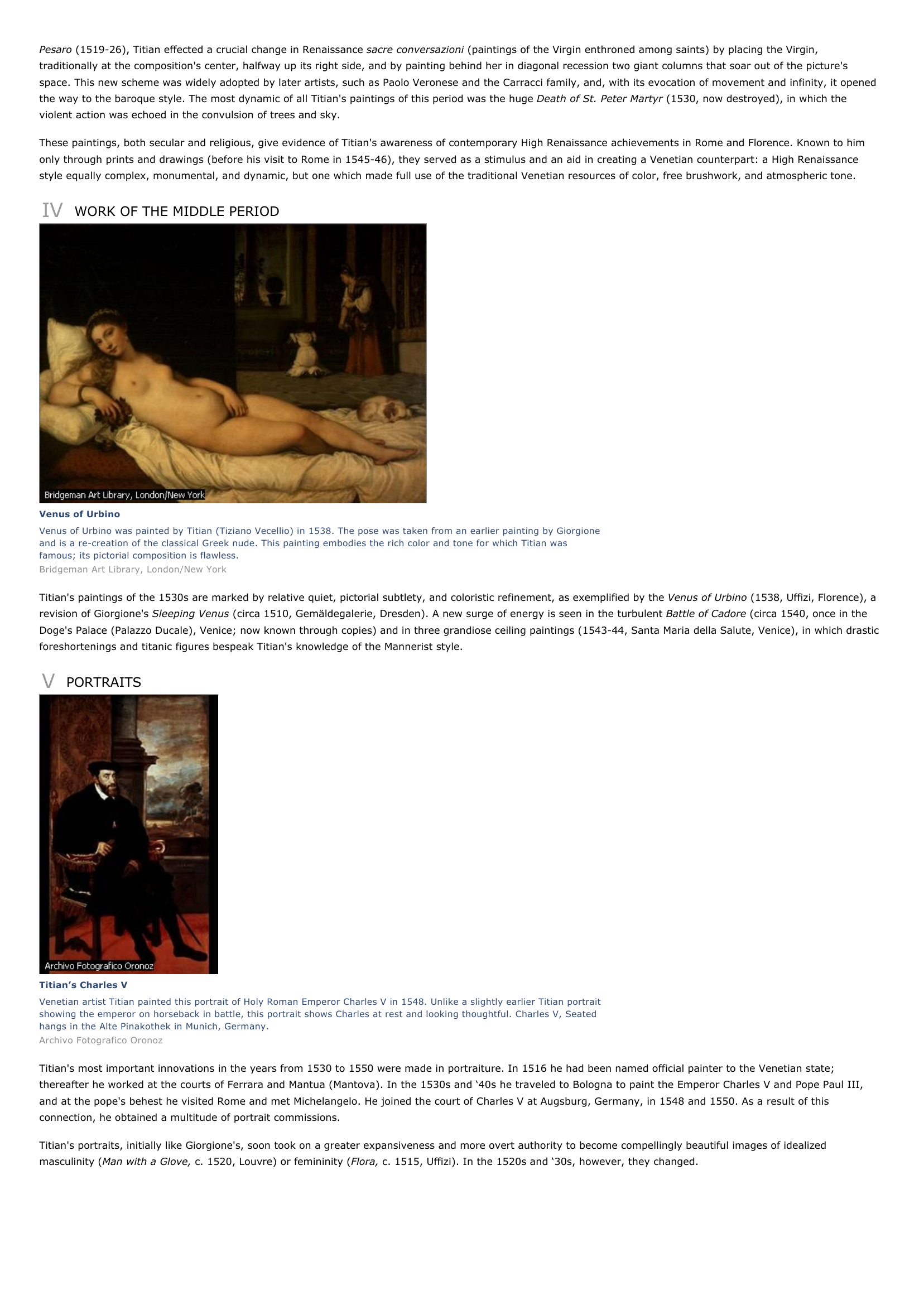Titian I INTRODUCTION Titian (1477?
Publié le 12/05/2013

Extrait du document
«
Pesaro (1519-26), Titian effected a crucial change in Renaissance sacre conversazioni (paintings of the Virgin enthroned among saints) by placing the Virgin, traditionally at the composition's center, halfway up its right side, and by painting behind her in diagonal recession two giant columns that soar out of the picture'sspace.
This new scheme was widely adopted by later artists, such as Paolo Veronese and the Carracci family, and, with its evocation of movement and infinity, it openedthe way to the baroque style.
The most dynamic of all Titian's paintings of this period was the huge Death of St.
Peter Martyr (1530, now destroyed), in which the violent action was echoed in the convulsion of trees and sky.
These paintings, both secular and religious, give evidence of Titian's awareness of contemporary High Renaissance achievements in Rome and Florence.
Known to himonly through prints and drawings (before his visit to Rome in 1545-46), they served as a stimulus and an aid in creating a Venetian counterpart: a High Renaissancestyle equally complex, monumental, and dynamic, but one which made full use of the traditional Venetian resources of color, free brushwork, and atmospheric tone.
IV WORK OF THE MIDDLE PERIOD
Venus of UrbinoVenus of Urbino was painted by Titian (Tiziano Vecellio) in 1538.
The pose was taken from an earlier painting by Giorgioneand is a re-creation of the classical Greek nude.
This painting embodies the rich color and tone for which Titian wasfamous; its pictorial composition is flawless.Bridgeman Art Library, London/New York
Titian's paintings of the 1530s are marked by relative quiet, pictorial subtlety, and coloristic refinement, as exemplified by the Venus of Urbino (1538, Uffizi, Florence), a revision of Giorgione's Sleeping Venus (circa 1510, Gemäldegalerie, Dresden).
A new surge of energy is seen in the turbulent Battle of Cadore (circa 1540, once in the Doge's Palace (Palazzo Ducale), Venice; now known through copies) and in three grandiose ceiling paintings (1543-44, Santa Maria della Salute, Venice), in which drasticforeshortenings and titanic figures bespeak Titian's knowledge of the Mannerist style.
V PORTRAITS
Titian’s Charles VVenetian artist Titian painted this portrait of Holy Roman Emperor Charles V in 1548.
Unlike a slightly earlier Titian portraitshowing the emperor on horseback in battle, this portrait shows Charles at rest and looking thoughtful.
Charles V, Seatedhangs in the Alte Pinakothek in Munich, Germany.Archivo Fotografico Oronoz
Titian's most important innovations in the years from 1530 to 1550 were made in portraiture.
In 1516 he had been named official painter to the Venetian state;thereafter he worked at the courts of Ferrara and Mantua (Mantova).
In the 1530s and ‘40s he traveled to Bologna to paint the Emperor Charles V and Pope Paul III,and at the pope's behest he visited Rome and met Michelangelo.
He joined the court of Charles V at Augsburg, Germany, in 1548 and 1550.
As a result of thisconnection, he obtained a multitude of portrait commissions.
Titian's portraits, initially like Giorgione's, soon took on a greater expansiveness and more overt authority to become compellingly beautiful images of idealizedmasculinity ( Man with a Glove, c.
1520, Louvre) or femininity ( Flora, c.
1515, Uffizi).
In the 1520s and ‘30s, however, they changed..
»
↓↓↓ APERÇU DU DOCUMENT ↓↓↓
Liens utiles
- Claude Bernard : Introduction à l'étude de la médecine expérimentale (fiche de lecture)
- Introduction à la Griotique
- Introduction à la recherche documentaire
- introduction à l'écologie
- Résumé introduction à la socio histoire de Gérard Noiriel







